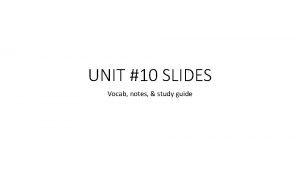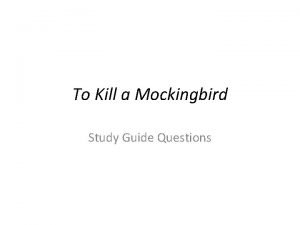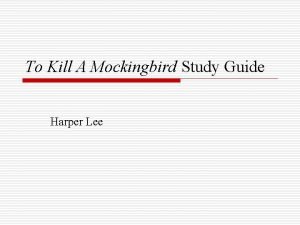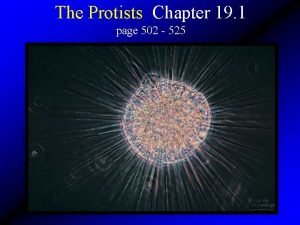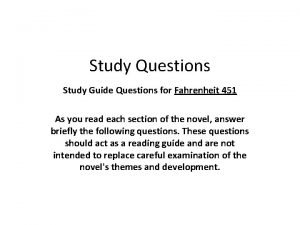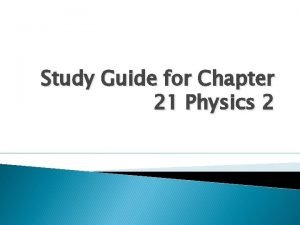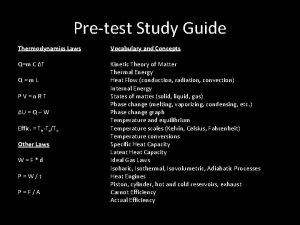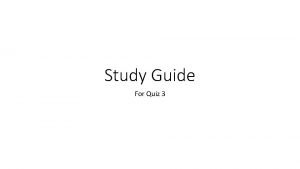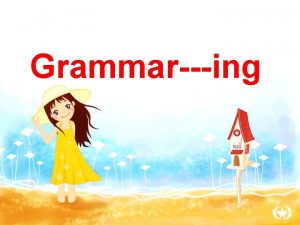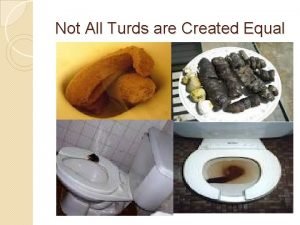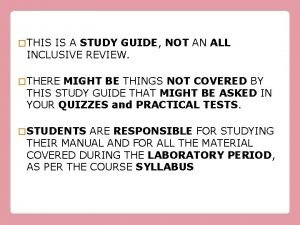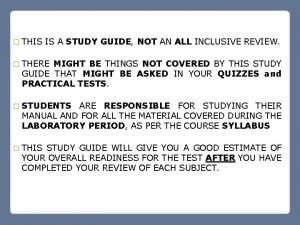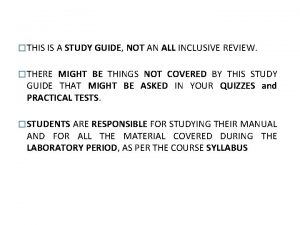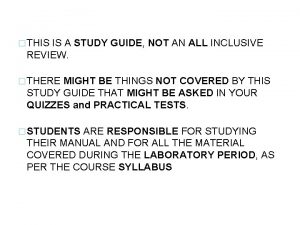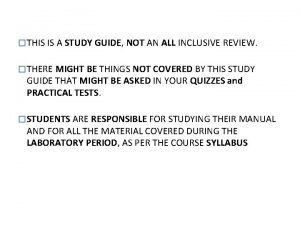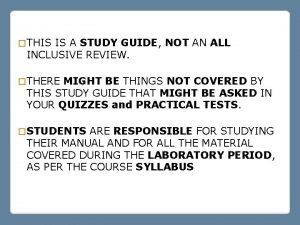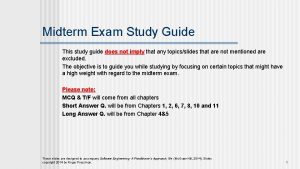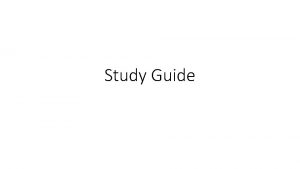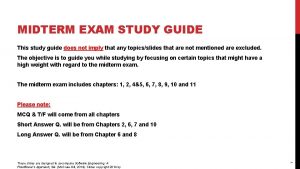THIS IS A STUDY GUIDE NOT AN ALL


























- Slides: 26

� THIS IS A STUDY GUIDE, NOT AN ALL INCLUSIVE REVIEW. � THERE MIGHT BE THINGS NOT COVERED BY THIS STUDY GUIDE THAT MIGHT BE ASKED IN YOUR QUIZZES and PRACTICAL TESTS. � STUDENTS ARE RESPONSIBLE FOR STUDYING THEIR MANUAL AND ALL THE MATERIAL COVERED DURING THE LABORATORY PERIOD, AS PER THE COURSE SYLLABUS.

Lab # 6 Skeletal System I

Structure of a Long Bone Proximal epiphysis Articular cartilage Epiphyseal plate/line Spongy bone Diaphysis Endosteum Periosteum Compact bone Distal epiphysis Medullary cavity

Histology of Osseous Tissue It is the structural and functional Osteon unit of the compact bone Concentric lamellae External circumferential lamellae Interstitial lamellae Periosteum It is dense irregular connective tissue Trabeculae of spongy bone Perforating (Sharpey’s) fibers They anchor the periosteum to the bone Central (Harversian) canals They contain blood capillaries, lymphatic vessels, and nerves They lie perpendicular to the Perforating (Volkmann’s) osteon and carry blood vessels canals with blood vessels into the bone from the periosteum.

Histology of Osseous Tissue Interstitial lamellae Osteocyte in lacuna Empty lacuna Central (Harversian) canal Concentric lamellae Artery Vein Nerve

Classification of Bones by Shape � Long bones Longer than wide. They serve as rigid levers that are acted upon by skeletal muscles to produce body movements. Bones of the upper and lower limbs excluding the ankle and wrist bones. � Flat bones � Short bones They are equal in length and width. They glide across one another in multiple directions. Bones of the wrist and the ankle. � Irregular bones They protect soft organs. They are curved but wide & thin. They have elaborate shapes that don’t fit into the other categories. The ribs, the sternum, the clavicles, bones of pelvis and some skull bones. The vertebrae and certain skull bones.

Skeletal System Axial Skeleton Appendicular Skeleton

Axial Skeleton Skull Hyoid bone Vertebral column Thoracic or rib cage

Cranial bones Skull Facial bones 1 - Frontal (1) 2 - Parietal (2) 3 - Temporal (2) 4 - Occipital (1) 5 - Sphenoid (1) 6 - Ethmoid (1) Sutures 1 - Maxilla (2) 2 - Zygomaticus (2) 3 - Lacrimal (2) 4 - Nasal (2) 5 - Palatine (2) 6 - Mandible (1) 7 - Vomer (1) 8 - Inferior nasal concha (2)

B. and C. Cranial and Facial Bones Coronal suture FRONTAL BONE Squamous suture PARIETAL BONE SPHENOID BONE TEMPORAL BONE ETHMOID BONE Zygomatic process NASAL BONE Squamous region LACRIMAL BONE Lambdoid suture External acoustic meatus ZYGOMATIC BONE MAXILLA OCCIPITAL BONE Mastoid process Styloid process Body of mandible MANDIBLE CRANIAL BONES FACIAL BONES Lateral view

Anterior view FRONTAL BONE NASAL BONE PARIETAL BONE TEMPORAL BONE SPHENOID BONE LACRIMAL BONE ETHMOID BONE Middle nasal concha (part of ethmoid) Perpendicular plate of ethmoid bone ZYGOMATIC BONE Zygomatic process of maxilla VOMER INFERIOR NASAL CONCHA MAXILLA MANDIBLE CRANIAL BONES FACIAL BONES

Nasal septum Vomer Perpendicular plate Cartilage of ethmoid of septum Middle nasal concha Inferior nasal concha

Hard palate Palatine process of maxilla PALATINE BONE Cribriform plate of ethmoid bone MAXILLA Crista galli of Ethmoid bone Lesser wing Greater wing Sella turcica Anterior cranial fossa Styloid process TEMPORAL BONE Mastoid process OCCIPITAL BONE Inferior view Foramen magnum SPHENOID BONE Middle cranial fossa Petrous region of TEMPORAL BONE Posterior cranial OCCIPITAL fossa BONE Interior view

Coronal suture Sagittal suture PARIETAL BONE FRONTAL BONE PARIETAL BONE Lambdoid suture OCCIPITAL BONE PARIETAL BONE TEMPORAL BONE Mastoid process MANDIBLE Lambdoid suture Posterior view Superior view OCCIPITAL BONE

Sella turcica PARIETAL Sphenoidal sinus FRONTAL Crista galli Frontal sinus TEMPORAL Ethmoidal sinus SPHENOID OCCIPITAL Mastoid process Styloid process Midsagittal view ETHMOID Cribriform plate of ethmoid Perpendicular plate of ethmoid Palatine process of maxilla PALATINE BONE

The Mandible Coronoid process Mandibular condyle Mandibular rami Body of mandible Mandibular angle Lateral view

Vertebral Column Cervical region C 7 T 1 Atlas (C 1) Thoracic region Axis (C 2) Intervertebral discs T 12 L 1 Lumbar region L 5 Sacrum Intervertebral foramina Sacral region Coccyx Coccygeal region Lateral view

Vertebra (prototype) Spinous process Vertebral foramen Transverse process Vertebral body Inferior view

Atlas (C 1) Transverse process Axis (C 2) Vertebral foramen Transverse foramen Superior view Dens or odontoid process Atlanto-axial joint

Cervical Vertebra Spinous process Vertebral foramen Body Transverse foramen Superior view Transverse process Spinous process Transverse process Lateral view

Thoracic Vertebra Spinous process Transverse process Superior costal facet for head of rib Vertebral foramen Body Spinous process Superior view Inferior costal facet for head of rib Lateral view

Lumbar Vertebra Spinous process Transverse process Body Vertebral foramen Body Superior view Spinous process Lateral view

A comparison of vertebrae from cervical, thoracic and lumbar regions Superior view Lateral view Cervical (7) Thoracic (12) Lumbar (5)

Transverse foramina Intervertebral foramina Vertebral foramen Transverse foramina of cervical vertebrae are passageways for vertebral artery (and vein, no shown) Intervertebral foramina are passageways for spinal nerves running to or from the enclosed spinal cord Together, the vertebral foramina of successive vertebrae form the vertebral canal , which encloses the spinal cord

Sacrum and Coccyx Sacrum (Fused components of 5 vertebrae) S 1 S 2 Median sacral crest S 3 S 4 Anterior view Coccyx (3 to 5 coccygeal vertebrae) S 5 Posterior view Sacral foramina Coccyx

Sternum and Ribs T 1 1 1 Manubrium 1 2 Costal cartilages 3 4 2 3 4 5 5 Xiphoid process 6 6 3 3 True ribs (ribs 1 -7) 4 4 5 They are connected to the sternum by separated costal cartilages 5 6 7 7 2 2 B o d y 1 6 7 7 T 12 False ribs (ribs 8 -10) L 1 11 12 Floating ribs 12 11 Floating ribs
 Not genuine, not true, not valid
Not genuine, not true, not valid Edna st vincent millay love is not all
Edna st vincent millay love is not all Name all rays
Name all rays World geography spring final review
World geography spring final review Westb test
Westb test Unit 10 study guide answer key
Unit 10 study guide answer key Unit 1 test study guide answer key
Unit 1 test study guide answer key Us history final exam study guide
Us history final exam study guide What college did morrie and mitch first meet
What college did morrie and mitch first meet Who gave cole the at.oow blanket
Who gave cole the at.oow blanket Identify mr dolphus raymond
Identify mr dolphus raymond To kill a mockingbird study guide
To kill a mockingbird study guide Sexual reproduction in paramecia is called _____.
Sexual reproduction in paramecia is called _____. Nc state bar board of paralegal certification
Nc state bar board of paralegal certification Describe the setup of montag's tv room
Describe the setup of montag's tv room Physics chapter 21 study guide answers
Physics chapter 21 study guide answers Define compound machines
Define compound machines Thermodynamics study guide
Thermodynamics study guide Abfm
Abfm Chapter 7 physics study guide answers
Chapter 7 physics study guide answers Physics: principles and problems chapter 6 answers
Physics: principles and problems chapter 6 answers Chapter 12 thermal energy study guide answers
Chapter 12 thermal energy study guide answers Chapter 11 study guide energy and its conservation answers
Chapter 11 study guide energy and its conservation answers Physical science final exam review
Physical science final exam review Science eoc review
Science eoc review Mgis 317 study guide
Mgis 317 study guide Parallel journeys quiz
Parallel journeys quiz





